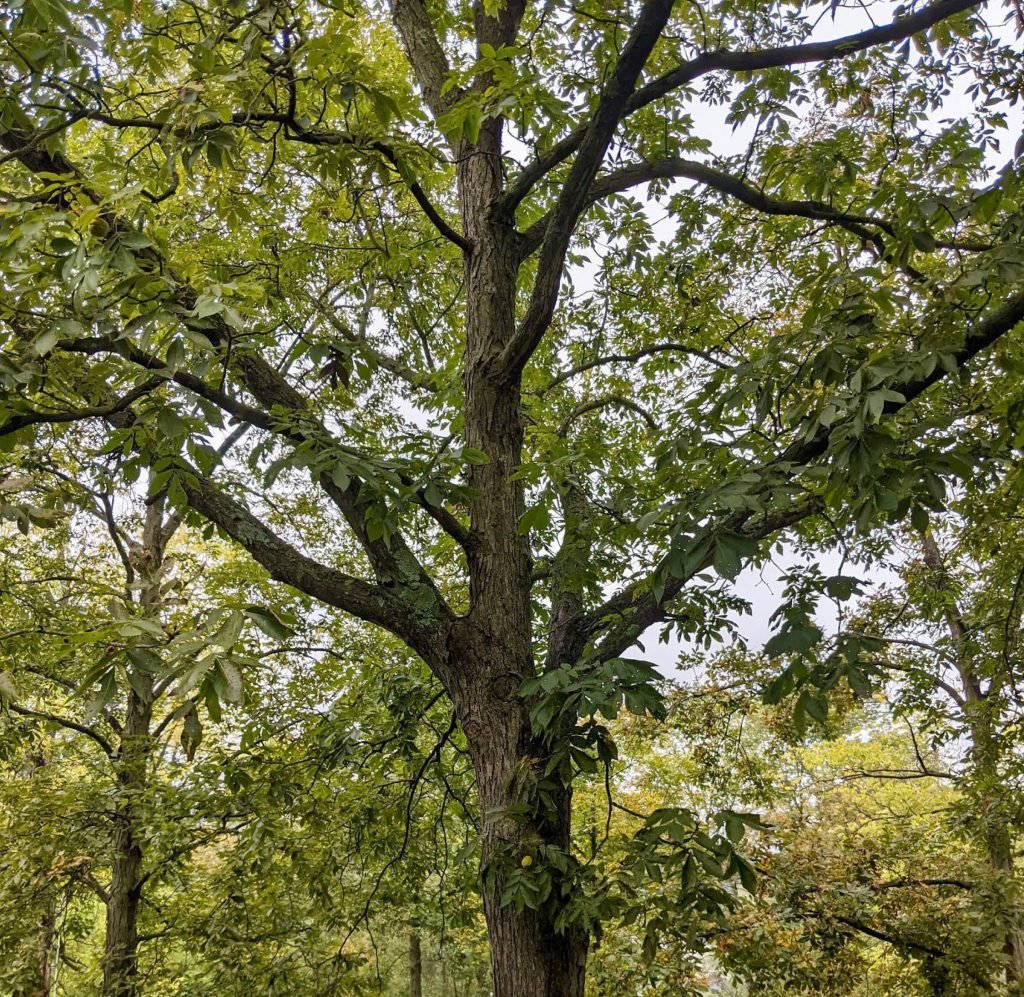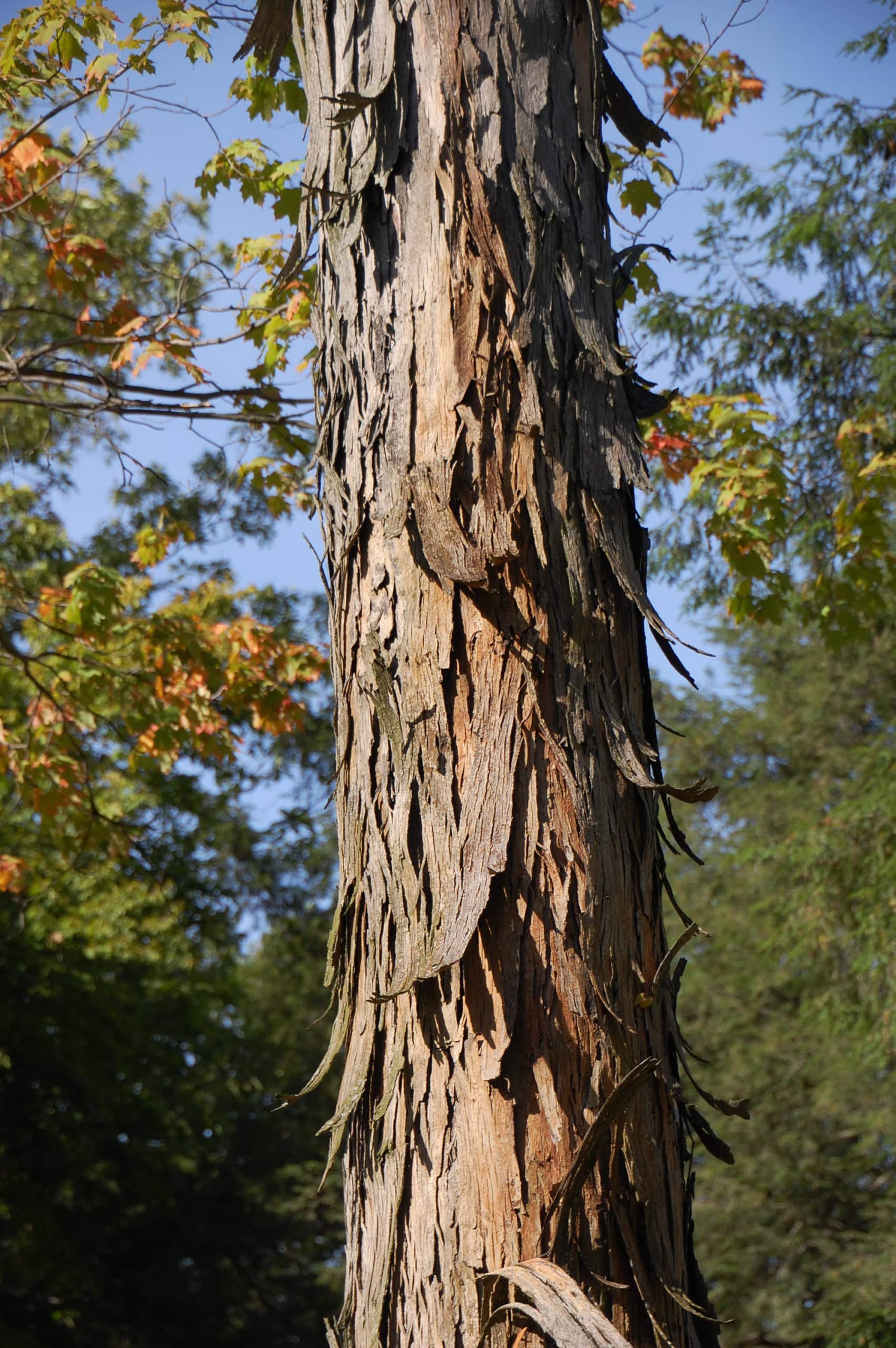Shagbark Hickory
Carya ovata. An iconic tree of the southern Maine forest, typically reaching heights of 70-120 FT, shagbark hickory requires ample space to grow and is deeply taprooted, making transplantation challenging. This large deciduous tree can live up to 200 years, and is typically slow to bare…plant them for your kids and grandkids. The growth is characterized by a tall, irregular to oval-shaped crown and a mature trunk typically 2-3 ft wide. It thrives in moist, nutrient-rich, well-drained soils and tolerates both full sun and partial shade It can adapt to various moisture conditions but performs best in well-drained soils.
Vibrant yellow to golden hue fall color. In spring, inconspicuous yellowish-green flowers with females developing into edible nuts, enclosed in a thick husk that splits into four pieces upon maturation in the fall. Cross-pollination enhances nut production. The bark starts off gray-brown and smooth when the tree is young, developing into long plates as the tree matures.
Native Americans and early settlers frequently consumed these nuts in early America and had many recipes including hickory ‘milk’ and ‘cheese’. Shagbark Hickory wood is prized for smoking or curing meats, as well as for its hardness, which makes it suitable for furniture, handles, and ladders.
Sold as bare root trees 12-14” tall.
Carya ovata. An iconic tree of the southern Maine forest, typically reaching heights of 70-120 FT, shagbark hickory requires ample space to grow and is deeply taprooted, making transplantation challenging. This large deciduous tree can live up to 200 years, and is typically slow to bare…plant them for your kids and grandkids. The growth is characterized by a tall, irregular to oval-shaped crown and a mature trunk typically 2-3 ft wide. It thrives in moist, nutrient-rich, well-drained soils and tolerates both full sun and partial shade It can adapt to various moisture conditions but performs best in well-drained soils.
Vibrant yellow to golden hue fall color. In spring, inconspicuous yellowish-green flowers with females developing into edible nuts, enclosed in a thick husk that splits into four pieces upon maturation in the fall. Cross-pollination enhances nut production. The bark starts off gray-brown and smooth when the tree is young, developing into long plates as the tree matures.
Native Americans and early settlers frequently consumed these nuts in early America and had many recipes including hickory ‘milk’ and ‘cheese’. Shagbark Hickory wood is prized for smoking or curing meats, as well as for its hardness, which makes it suitable for furniture, handles, and ladders.
Sold as bare root trees 12-14” tall.
Carya ovata. An iconic tree of the southern Maine forest, typically reaching heights of 70-120 FT, shagbark hickory requires ample space to grow and is deeply taprooted, making transplantation challenging. This large deciduous tree can live up to 200 years, and is typically slow to bare…plant them for your kids and grandkids. The growth is characterized by a tall, irregular to oval-shaped crown and a mature trunk typically 2-3 ft wide. It thrives in moist, nutrient-rich, well-drained soils and tolerates both full sun and partial shade It can adapt to various moisture conditions but performs best in well-drained soils.
Vibrant yellow to golden hue fall color. In spring, inconspicuous yellowish-green flowers with females developing into edible nuts, enclosed in a thick husk that splits into four pieces upon maturation in the fall. Cross-pollination enhances nut production. The bark starts off gray-brown and smooth when the tree is young, developing into long plates as the tree matures.
Native Americans and early settlers frequently consumed these nuts in early America and had many recipes including hickory ‘milk’ and ‘cheese’. Shagbark Hickory wood is prized for smoking or curing meats, as well as for its hardness, which makes it suitable for furniture, handles, and ladders.
Sold as bare root trees 12-14” tall.




